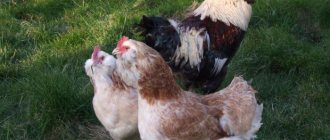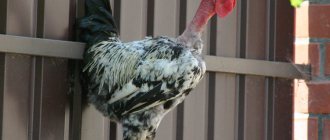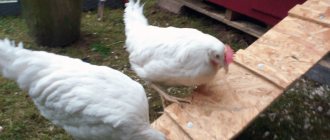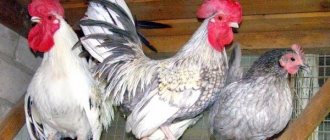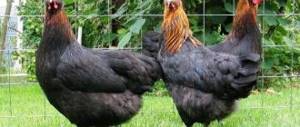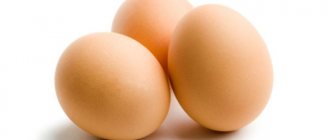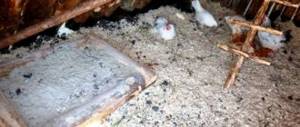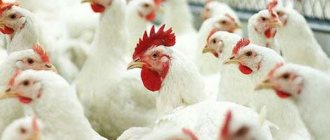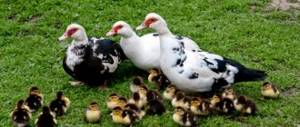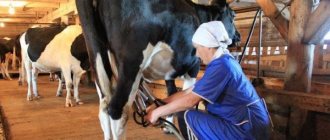Content
To obtain quality products, a farmer should adhere to certain principles.
Oryol chicken is well adapted to cold winters, but the chicken coop must be insulated. Oryol chickens are incompatible with other birds. They are very aggressive. The rooster always shows who is in charge in the territory. Therefore, it is necessary to organize separate poultry houses or aviaries for them. If necessary, cages are arranged. Feeders in the coop should be adjusted to accommodate short and curved beaks.
Nutrition
The characteristics and description of care indicate that Oryol chickens are unpretentious in feeding. Nutrition is the same as for other varieties. The main thing is to diversify it. This could be grains, vegetables, dairy products, boiled potatoes, food waste. Compound feeds with a special composition are also suitable.
The diet of this breed of chickens should be varied: grains, vegetables, dairy products, boiled potatoes, food waste
Sitseva’s daily diet includes the following:
- mineral supplements;
- sand;
- gravel.
The description of the Oryol calico breed of chickens includes feeding characteristics, which includes pasture: beetles, worms, etc. But this is not enough for full growth and development. In early spring, when the birds are exhausted, they add fresh greens to their diet and make a mixture of first grass and bush onions.
It is changed in time for fresh one so that it does not stagnate. In the spring, it is also useful to add oil-based vitamins, mineral supplements, manganese, flint mixtures, and solutions with a high iron content to the drink of the Orlov breed of chickens.
Diseases
To prevent diseases and infections, the premises are regularly disinfected. The description of the weak points of this subspecies indicates a special sensitivity to down feather eaters. When such a disease appears in a poultry yard, the Oryol calico chicken is the first to be pecked, mortality increases, and the quality of productivity rapidly decreases.
The second danger awaits individuals in wet weather. They are very sensitive to coolness, which is often why the feet become hypothermic. To avoid paralysis in young animals, you should carefully monitor the quality and density of the litter.
Shedding
Domestic Oryol chicken does not tolerate the period of natural molting well; laying hens can get sick when changing plumage, quickly lose strength and experience enormous stress when in contact with other types of economic birds. If you do not protect them from roosters, aggressive turkeys and geese during this period, mortality increases significantly. At this time, they monitor the quality of the litter and add more vitamins and greens to the food.
The rooster of the Oryol breed also does not tolerate the period of changing feathers well: young animals show aggression, fights between males become more frequent, and they are more cruel. At this time, cockerels tend to beat hens and other inhabitants of the poultry yard.
Reproduction
Oryol breed chickens are not easy to acquire. They may only be available to collectors. This breed is not for industrial use, although its meat productivity is excellent.
There are a number of difficulties that arise when raising a young chicken. The young are tender and require special attention and care from the farmer. The chicks take a long time to fledge. Because of this, chickens experience a high mortality rate.
Oryol calico. Chickens..
Exterior of the Oryol breed of chickens, Russian type. Kennel of Alexander Mukhanov
Birds in Kursk "Oryol calico"
Chickens Oryol Calico
Orlov calico chickens
Character
Based on genetic characteristics, it can be assumed that “eagles” have a tough temperament, since fighting blood flows in their veins. But it is not so. Roosters are a little aggressive, but they don’t attack without reason and get along quite well within their species.
The Oryol breed of chickens is not suitable for keeping together with representatives of other varieties, because this can lead to various conflicts and even losses. In general, winged beauties are very active, loud and restless. Klushi lead a more measured lifestyle, pliable and obedient.
Description and characteristics of Orlovskaya calico chickens
Oryol roosters became famous for their unusual appearance, cockiness and upright body. Their plumage is thick and, as a rule, variegated and multi-colored. These chickens are considered ornamental birds. They are bred mainly by fans of show breeds.
What do birds look like?
Oryol chickens have a powerful body, long neck, and lush plumage. The bird's height is about 60 centimeters. Roosters have a slender, fighting figure, the neck has a fighting bend. They stick their chest forward. The body is located almost vertically. The head is small, flat. The beak is yellowish, short, curved. Eyes with overhanging brow ridges, coloring - reddish-amber.
The legs are strong, tall, muscular, yellowish in color, without feathers. The feathers on the nape are raised. In front, the feathers form a semblance of sideburns and a beard. The tail is long and bushy. The comb is small, crimson in color, with small bristles. The earlobes and earrings are poorly developed. Laying hens are more squat, but in other respects they are similar to roosters. The plumage of birds can be bright red, walnut, calico (red-black-white), yellowish, white, mahogany, and black.
Productive qualities of the breed
Oryol chickens belong to the meat and egg breed. Adult roosters weigh 3-4.5 kilograms. The weight of laying hens is 2.5-3 kilograms. In a year, a chicken can lay almost 180 eggs. With age, the egg production of laying hens decreases to 120, 100 eggs. The weight of one egg is 60 grams. The shell is cream or pale pink in color. Laying hens begin laying eggs at seven months of age. Maximum weight is gained in 2 years. The meat is tough and tastes vaguely like game.
Description and characteristics of the Andalusian blue chicken breed, maintenance rulesRead
Character of chickens
The Oryol breed adapts well to any climate, tolerating severe frosts and cool, rainy weather. True, the chicks fledge slowly and require special care in the first weeks of life.
Laying hens have a calm character. They have a poorly developed egg incubation instinct. Previously, before the advent of hybrids, this feature of the breed resulted in greater egg production compared to other domestic chickens. Roosters are strong, cocky, aggressive. It is better not to house them with other poultry.
Features of keeping Yurlovsky vocal chickens
Birds of the Yurlov breed are distinguished by their endurance, resistance to diseases and unpretentiousness to living conditions. At the same time, the temperature regime of the poultry house is important for them. For good productivity, the temperature in the poultry house should not fall below 12°C. Daylight hours should last 13–14 hours.
There should be no drafts in the room, but fresh air circulation is necessary. The volume of the room per individual should be 0.5 m³.
The best flooring for a poultry house is a deep, permanent litter of peat, straw or sawdust. These substrates absorb moisture well. If necessary, add material. Take out the litter 2 times a year.
Poultry house equipment also matters. Chickens of the Yurlovsky breed need perches and nests with bedding made of straw and bran at a height of at least 1 m from the ground. Since the breed is characterized by active searching behavior, they must have sufficient walking.
Care
For each vocal hen, plan 10 cm of feeding and 2.5 cm of watering. It is necessary to select feeders that are protected from raking out and spilling of feed. The feeder is filled no more than a third. For mineral additives (shell rock, chalk, limestone, gravel), a separate feeder is installed.
Drinkers use vacuum, nipple, groove
It is important to reduce splashing of water onto the litter and clogging of the drinking bowl with droppings and bedding material
As a result of wet litter, diseases of vocal breed chickens such as coccidiosis, necrobacteriosis, pododermatitis, etc. occur.
If necessary, dry wet areas using quicklime.
The bird of the Yurlovsky vocal breed is highly resistant to diseases.
If they have free-range housing, proper feeding and the creation of optimal conditions in the poultry house, they are not afraid of diseases.
Feeding
An adult vocal bird must be limited in feeding. Excess feed will lead to obesity in the oviduct in laying hens and excessive weight gain in roosters, which is fraught with loss of productivity, injury and increased culling of hens. Birds of the vocal breed, which are raised for meat, are fed ad libitum with food with a high protein content until slaughter.
The basis of nutrition for laying hens should be grains and high-quality compound feed. In winter, a chicken should receive 100 g per head, and a loud rooster - 150 g of whole and chopped grain, 50 and 100 g, respectively, of succulent feed (pumpkin pulp, zucchini). Fishmeal, cottage cheese, and whey are used as protein components.
In the absence of walking, high-calorie foods such as boiled potatoes, sunflower or soybean cake and meal are limited. After the appearance of fresh grass and the organization of daily walking, the amount of grain in the diet is reduced.
Breeding
To maintain a vocal breed at home, it is necessary to take into account some selection features:
- When recruiting families to obtain high fertility, 1 productive rooster is needed for every 12–20 hens. The exact number of vocal laying hens depends on the age and activity of the male.
- For incubation, eggs are selected that were laid no later than 6 days ago, of medium size, weighing at least 52 g, of regular shape and with a dense, smooth shell without visible damage.
- Chickens of the Yurlovsky vocal breed have a pronounced brooding instinct and can hatch chicks naturally. Up to 17 eggs are placed under one hen. The nest with the hen should be placed in a warm, dark place, with a feeder and drinking bowl placed nearby.
- Artificial incubation of eggs is possible. The technology takes into account a gradual decrease in temperature in the incubation chamber, turning and moistening the eggs.
- To preserve the breed, it is necessary to update the herd.
- In order to increase the productivity of poultry, it is necessary to select for breeding laying hens with a live weight of at least 2 kg and with good egg production.
How to properly keep Oryol chickens
When breeding any birds, it is important to create all the necessary conditions for normal growth and development, otherwise you should not expect high productivity from the bird.
Keeping Oryol chickens does not require high material and labor costs, but there are some features that deserve your attention.
Find out also about the rules for keeping such meat and egg breeds as: dominant, Kuchinskaya, Zagorskaya salmon, Amrox, Wyandotte, Leningrad calico, Livenskaya.
Chicken coop requirements
A standard chicken coop with several windows and good ventilation is quite suitable for the Oryol residents. Considering that these chickens tolerate cold well, in regions with a warm climate the building does not need to be insulated in winter. Inside the chicken coop, it is allowed to divide into several pens or keep the birds in cages, but always with regular walking.
For the winter, the floor of the room is covered with sawdust and covered with a bedding of dry straw, which is burned when spring arrives. Also, in winter, birds will need additional lighting, which will increase their egg production.
Important! Sharing with other breeds is undesirable, therefore, when breeding a large number of different chickens, Oryols will have to be kept in separate enclosures inside the chicken coop.
Walking yard
Walking is important for any poultry, so it is advisable to organize a small fence next to the chicken coop with free access to it. If the size of the plot allows, it is desirable that there be at least 0.5–1 m of walking area per bird, and without the presence of representatives of other breeds on it.
Approximately 1/3 of the run should be covered with tin or other covering material so that the chickens can hide under a canopy from the rain and scorching sun.
Feeders and drinkers
Considering the special structure of the beak of Oryol chickens, it is not surprising that feeders and drinkers for them must meet certain requirements, which are expressed as follows:
- placement - no higher than 20–30 cm above floor level, so that it is convenient for the chicken to drink or take food;
- depth - no more than 10 cm, taking into account the parameters of the bird’s beak;
- sectionality - long feeders should be divided into several compartments so that the birds do not interfere with each other while eating;
- The material must be easy to clean, allowing you to quickly and efficiently clean drinking bowls or feeders from mold and food debris.
The amount of such equipment should correspond to the number of birds, especially when it comes to wet bryozoans and other quickly eaten food.
You will be interested in reading how to make a bunker feeder for chickens with your own hands, as well as how to make an automatic waterer for chickens with your own hands.
Feeding chickens
Many poultry farmers consider Orlov residents to be undemanding when it comes to food, but at the same time, their diet should be as varied and balanced as possible, with the presence in it of:
- root vegetables;
- whole and crushed grains;
- boiled potatoes;
- dairy products (sometimes kneading with kefir is allowed);
- leftover food from the table;
- herbs from the garden and garden (in summer).
If necessary, you can use ready-made feed, and mineral supplements, fine gravel and sand, which are poured into separate feeders, are perfect for additional feeding.
Do not forget to monitor the freshness of the water: it should not stagnate in the drinking bowls. Grain can be left in feeders throughout the day, but wet mash is given to the birds 1-2 times a day with mandatory quality control.
Molting and break in egg production
With good nutrition in an insulated poultry house, some representatives of Oryol chickens may not stop laying eggs, but most often the decrease in the number of eggs obtained is explained by molting in the pre-winter period. The duration of feather change and absence of egg laying is strictly individual for each bird, but on average does not exceed 1 month.
Did you know? Sometimes there are two yolks in one egg, but it won’t turn into twins: two embryos simply won’t fit under the shell.
Planned herd replacement
Oryol birds reach their maximum egg production in the second year after birth and maintain good productivity indicators for another year. This also applies to weight indicators, which means that a planned replacement of the flock can be carried out after 3–4 years of successful keeping of birds.
Advantages and disadvantages
Oryol chickens were not lost due to the following positive qualities:
- Birds have a decorative appearance.
- Laying hens lay eggs all year round.
- Chickens are resistant to cold weather.
- Birds provide a significant amount of meat.
- Birds do not require special care.
Attention! Some farmers consider the maternal instinct of laying hens to be one of the advantages of the breed. However, according to the observation of many owners, chickens do not have a high tendency to incubate
Birds are not without their disadvantages:
- chickens fledge slowly, so the risk of mortality of young animals at an early age is high;
- laying hens mature late;
- chickens do not have high rates of egg laying;
- cocky roosters are capable of harming other residents of the farmstead.
Breeding and rearing
The brooding instinct of Oryol chickens is completely absent, so they abandon eggs even if they have laid eggs. Breeding the breed is possible only using an incubator. To breed the Oryol individual, you can use eggs laid by pullets from the second year of life. Younger individuals do not produce a full-fledged egg. Incubation of eggs is no different from other breeds, but further care requires some special conditions.
Oryol chicks must have enough room to move.
Oryol chicken chicks grow slowly and do not fledge for a long time, so they need careful care, especially in the first month after hatching.
One of the main conditions is sufficient space for the chickens to move around. They must run for proper muscle development. If there is no room to run, the chickens will develop weak legs. Rapid growth and proper development are ensured by the Eagle chickens walking in the fresh air. From 2 months of age, in warm weather, chickens can spend the whole day outside.
Since chicken feathers begin to grow quite late, they need to be kept in a dry, heated room for the first two months. Moisture in the litter when raising chickens is not acceptable.
Chickens are fed according to the following scheme:
- 1-5 days – chopped boiled egg or cottage cheese with corn flour or boiled millet.
- 5-10 days – wet mash on the return. The mash is based on special mixed feed, wheat bran, finely chopped greens, and boiled carrots.
- From days 1 to 10, feeding is carried out 6-7 times per knock.
- From 10 to 30 days – 4 – 5 times.
- From the 30th day – 3 times.
For the first two months, chickens are kept in a dry, heated room.
Natalia. I bought Orlovtsy three years ago and am very pleased. The birds are stately, beautiful, and fly steadily. The rooster is important and proud. He doesn’t just get into a fight, but he won’t hurt his chickens for anything. The chickens are simply tame. They even purr somewhat like a cat.
Lydia. I have 3 hens and 1 rooster of the Oryol breed. 3 chickens produce 2 eggs daily. I don’t agree with the opinion about the impossibility of keeping them with other chickens. Everyone lives in a crowd, the rooster doesn’t attack anyone. The truth is that he doesn’t allow other roosters to approach his ladies.
Stepan. Breeding Oryol chickens causes many problems. It is difficult to maintain breed characteristics and ensure proper development of chickens. The meat is rougher after 8-9 months, so I don’t recommend raising roosters to adulthood. The eggs are small, despite the size of the chickens themselves.
We offer you a video review of the Orlovskaya chicken breed. We wish you pleasant viewing!
Bird colors
These birds have several subspecies in color:
- Oryol calico chickens.
- Scarlet colored chickens.
- The so-called mahogany birds.
- Variegated, black, white birds and specimens painted in a mixture of these colors.
The calico breed is considered the most common. Her roosters are colored in various light shades of brown and red. The chest, lower leg and belly of the bird are decorated with black feathers, on which white spots are visible. The flight feathers are brown on one side and black on the other, but the tips of all feathers are white. According to the standard, a bird is allowed to have up to 4 flight feathers of the first order, colored white. The wings must have a black stripe with a green tint. The tail should be black, and a thin white border is acceptable on the braids. The standard allows for a few white feathers in the upper braids of the tail.
Chickens are colored the same way, but their color tone is lighter than that of roosters. Large white spots in chickens are scattered throughout the body, but have a clear border of thin black stripes.
How to choose a purebred bird?
When selecting, you need to pay attention to the following characteristics:
- Height and body. Insufficient height or underdeveloped body are considered gross defects.
- The comb should have the correct shape, resembling a raspberry cut along the axis.
- The legs should be yellow and without feathers.
- There must be a scruff.
If the rooster has minor flaws - a barely noticeable defect in the comb or slight deviations in color - then it can be accepted. With the right approach, all these shortcomings can be eliminated and a purebred individual can be produced.
Productivity, character
One-year-old laying hens weigh 2.5–3 kg, roosters weigh about 3.5 kg. Puberty comes late. The owner will see the eggs when the bird is 7–8 months old. Egg production in the first year is 180 units, then the average is 150 – 160 units. Product weight is about 60 g, color is white with a pink tint or light cream.
Some chefs find chicken meat a bit tough. However, it has good taste. The direction of the breed is meat and egg. The birds are not suitable for industrial use, but private farmers receive enough product for personal use.
Laying hens are calm, quickly get used to people, and do not bother other residents of the poultry farm. However, roosters often show their fighting qualities. They are capable of severely damaging other birds and attacking their owner. To reduce the likelihood of conflicts, males are not kept together with birds of other breeds.
Breed standards
As a result of genetic experiments, Oryol residents have adapted to the harsh Russian winters. They belong to the category of one of the most resilient species of birds. In addition, they are distinguished by bright external data.
Females and males are tall, at least 60 cm tall. The bird is large, with well-developed muscles and bones.
Table 1. Appearance features.
| Part of the body | Description |
| Head | Similar to an eagle or falcon. Covered with protruding feathers forming a beard and sideburns. Thanks to its lush plumage, it is spherical. The wide forehead and brow ridges evoke associations with birds of prey. |
| Neck | Oblong with luxurious plumage. A characteristic feature is that the top is decorated with a scruff. Tapers towards the base. |
| Eyes | Deeply planted. They stand out against the background of overhanging arches of amber hue. |
| Beak | Small in size, hooked in shape. Powerful at the base and maximally curved at the end. In pre-revolutionary times, individuals with a characteristic “cleft” were preferred. |
| Scallop | Looks like a flattened and cut raspberry. Covered with small tubercles. It is located on the front of the forehead, low, almost falling onto the nostrils. |
| Beard | In the form of a wedge or hanging throat fold. |
| Body | Wide and short, vertical orientation. With great growth, the body is elongated. |
| Shoulders | Straight, inclined forward. |
| Back | Short and flat, tapering noticeably at the tail. |
| Wings | Middle length. They fit tightly to the body. |
| Tail | Full, set at right angles along the line of the spine. The braids are small, narrow, rounded. The upper ones stand out against the background of the rest of the plumage. |
| Breast | Slightly bulging forward. In males it is well muscled and well developed. |
| Stomach | Neat and selected. |
| Shin | Well defined, thick and long. |
| Legs | Strong, yellow. |
The shape of the beak resembles that of an eagle
Externally, females and males are similar to each other. Chickens are distinguished by a longer body, a poorly developed comb and a tail that is not so perpendicular to the back. But the plumage of the head is better designed.
Representatives of the Oryol breed have a very beautiful tail.
Birds of German selection have a lighter build. They are not as picturesque as Russian chickens, and do not have the eagle beak characteristic of the breed. The predominant colors are red-motley, mahogany, black, hawk and black-white-motley.
Breed faults
The following defects are considered reasons for rejection:
- small height;
- black beard;
- thin elongated beak;
- hunched back;
- plumage on the metatarsus and toes;
- horizontal positioning of the body;
- predominant brick color of feathers;
- little weight;
- color of the metatarsus and beak different from the standard one;
- insufficiently magnificent head decoration.
A narrow back or chest is also considered a defect
Plumage color
The feather fits tightly to the body and gives off a glossy shine. The classification of Oryol chickens depends on their colors:
- calico;
- motley;
- black-and-white;
- scarlet;
- white;
- mahogany;
- black;
- black and red.
Dwarf representatives of the breed were bred in Germany.
Rare color
The most common is calico plumage, which is characterized by red-motley and black-and-white patches on a brown background. Solid black and white individuals are rare.
Among the known subspecies, calico is considered the most popular
The prevailing color of roosters is from brick-clay to light brown. The peritoneum, chest and legs are covered with black feathers with white patches. The flight feathers are black at one end and dark brown with a white tip at the other. There is a black stripe with an emerald tint on the wing. The braids are edged with white and the tail is black. Females have almost the same color characteristics as males, but are several shades lighter.
The plumage of laying hens is more subdued
Productivity characteristics
According to productivity characteristics, the Orlov breeds belong to the meat-egg line.
Performance Features:
- weight of young males - from 3 to 3.5 kg;
- body weight of chickens - from 2.5 to 3 kg;
- weight of adult roosters - 4.5 kg;
- weight of overfed chickens—3.5 kg;
- Puberty of laying hens is later - the first clutch is at the age of 7-8 months;
- egg production indicators in 1 year - about 180 eggs, then decreases to 150;
- egg weight - from 58 to 60 g;
- the shell is dense, soft pink or cream in color.
Particularly productive chickens produce eggs weighing up to 100 g
Prices for an ovoscope for diagnosing eggs
Ovoscope
Advantages and disadvantages
Table 2. Pros and cons of the breed.
| Advantages | Flaws |
|
|
The disadvantage of the breed is considered to be low egg production.
Description and features
Bred in the 19th century, the breed meets the requirements of its time. Cold winter and wet weather are tolerated by the bird
Egg production practically does not drop, which is important given the high cost of eggs in winter. And the meat is endowed with a pleasant unconventional taste
Representatives of the breed are unpretentious to living conditions and food feed. But chickens are sensitive to cold and bad weather, as they grow and fledge slowly. They require special attention and approach.
Did you know? Chickens have the ability to recognize spoiled eggs. They often throw them out of the nest.
Find out what to do if chickens do not lay eggs well and what diseases the birds can get.
Appearance and physique
Roosters have the following characteristics:
- the body is raised, slender, vertical;
- legs are elongated, hardy, yellow without feathers;
- the neck is long and curved;
- skull with a wide, flat occipital bone and overhanging brow ridges;
- the chest is slightly convex;
- the beak is short, curved, yellow (predator species);
- the plumage of the neck and scruff forms a lush layer;
- the comb is small, crimson in color, with inconspicuous tubercles;
- the medium-length tail is directed upward and consists of beautiful feathers;
- the eyes are reddish-amber, deep-set;
- The earlobes and earrings are small, red, hidden under the beard and sideburns.
Color
Only after two years do representatives of the breed become fully developed and captivate with their true beauty. The color of eaglets varies widely. Black and white are distinguished by their uniform color. Scarlet individuals are endowed with a red-brown head and black back, body and chest. The most popular color is calico.
Red, black and white blotches are present throughout the plumage of these birds. There is the following color of the bird:
- scarlet (red, nutty) brown-breasted;
- scarlet (red, hazelnut) black-breasted;
- white;
- clayey (yellow);
- mahogany brown-breasted;
- black-breasted mahogany;
- striped;
- spotted red and white;
- calico (red-black-white);
- black.
Character
Orlovka chickens have a peaceful, balanced character. Roosters are aggressive and do not miss the opportunity to show strength and fighting qualities. Interestingly, the breed also attracts with its extraordinary appearance and beauty.
Important! Excessively frequent feeding of mashes leads to plucked beards, as the birds peck off the leftover food along with feathers from their fellow birds.
Hatching instinct
They cannot be made into brood hens, since the instinct to incubate eggs is completely absent. And to breed young animals, an incubator is needed.
Breeding and rearing
The brooding instinct of Oryol chickens is completely absent, so they abandon eggs even if they have laid eggs. Breeding the breed is possible only using an incubator. To breed the Oryol individual, you can use eggs laid by pullets from the second year of life. Younger individuals do not produce a full-fledged egg. Incubation of eggs is no different from other breeds, but further care requires some special conditions.
Oryol chicks must have enough room to move. Oryol chicken chicks grow slowly and do not fledge for a long time, so they need careful care, especially in the first month after hatching.
One of the main conditions is sufficient space for the chickens to move around. They must run for proper muscle development. If there is no room to run, the chickens will develop weak legs. Rapid growth and proper development are ensured by the Eagle chickens walking in the fresh air. From 2 months of age, in warm weather, chickens can spend the whole day outside.
Since chicken feathers begin to grow quite late, they need to be kept in a dry, heated room for the first two months. Moisture in the litter when raising chickens is not acceptable.
Chickens are fed according to the following scheme:
- 1-5 days – chopped boiled egg or cottage cheese with corn flour or boiled millet.
- 5-10 days – wet mash on the return. The mash is based on special mixed feed, wheat bran, finely chopped greens, and boiled carrots.
- From days 1 to 10, feeding is carried out 6-7 times per knock.
- From 10 to 30 days – 4 – 5 times.
- From the 30th day – 3 times.
For the first two months, chickens are kept in a dry, heated room.
Selection
Selection for a tribe cannot be carried out based on any one characteristic, for example, the shape of the body. After all, when crossing, all characteristics merge, including color. Therefore, the task of restoring the breed is more difficult than it might seem.
Breeders deal with both shape and color at the same time. Otherwise, the colors are lost and from white, black, yellow, only calico are obtained. But even when crossing individuals of the same color, for example calico, dark ones will certainly appear periodically. Such individuals must be culled.
If the goal is to remove the calico color, then others need to be rejected. This will allow you to fix the chintz color. Many breeders have difficulty breeding chickens of other colors. Thus, walnut or yellow individuals are very rare, because They are quite difficult to buy.
Currently, the breed of Oryol chickens is heterogeneous, and selection work will most likely continue for decades.
Optimal conditions of detention
One of the advantages of this old Russian breed of chickens is their unpretentiousness and endurance. They do not require a special diet or any special conditions of detention. Any amateur poultry farmer will be able to cope with breeding Oryol calico chickens.
Chickens of this breed of chickens develop slowly and often suffer from weak legs and crookedness.
Due to the fact that their plumage appears quite late, they are susceptible to colds during cold or damp weather. Due to these features, chickens should be kept on dry and warm bedding. Young animals need to run around and develop muscles, so more space needs to be allocated for them
This is especially important for fighting breeds
If it is warm enough outside, then chickens should begin to be walked from 1–2 months of age, since they grow worse in cramped spaces.
Natural living conditions are the best for Oryol calico chickens. They should spend most of their time outside. They feel great in any weather and are not afraid of either frost or rain.
Breeders who have experience in keeping this breed build rooms for them in which there is no heating or light, but there is an enclosure with free access.
For laying hens, nests are made at a height of about one meter from the floor level.
What to feed high-breed animals
There are no special requirements for the feeding diet of Oryol calicoes. Suitable for them:
- Grain mixtures from the store.
- Mixtures prepared independently: 30% each of barley and wheat and 5% each of sunflower seeds, millet, unrefined buckwheat, and corn.
- Compound feed for poultry that contains vitamin supplements, proteins, and minerals.
- Various wet mash: boiled potatoes with the addition of steamed barley, meat and bone meal, fish waste.
Interesting: How to determine how many years chickens live?
Supplement to main feed:
- From August to October you should add oats.
- Chickens need iron to develop muscles and increase egg production. Therefore, unrefined buckwheat is added to their main diet.
- In summer, chickens need succulent young grass (nettle is best).
- Vegetables (carrots, cabbage, beets), seeds, and hay are added.
- Chickens also need sources of protein contained in soybean meal and cake (up to 20%).
It is worth noting that feeders should have easy access. Given the small size of the beak, there must be adequate provisions for water and food.
Analogs
Oryol chickens are a unique family of birds. They are unique in their essence, and it is very difficult to find a replacement for this species. If you cannot find representatives of this particular species, you can replace them with similar ones. Of course, the analogue will not be the desired copy.
Here are some representatives of the egg-laying chicken family that can compete with Oryol chickens:
- Malayan fighting . They have the same dense constitution, strong legs and slender body, well-developed bones. The lower leg muscles of both breeds are developed almost identically. The productivity and egg production of both are practically at the same level.
- Yurlovsky vocal chickens. Similar in constitution, they are also distinguished by good productivity and endurance. In addition, they have a wonderful voice, so they will delight their owners with their wonderful singing.
To summarize, we can say with confidence that this type of chicken is characterized by high productivity and is one of the optimal ones for breeding. The disadvantage of the breed is its pretentiousness in care and high requirements for living conditions.
Feeding an adult herd
The adult family is raised according to the traditional pattern. For a feathered flock, it is necessary to use balanced feed according to age, greens and vegetables.
The periodic appearance in the feeder of an adult family of products that contain animal proteins - fermented milk products, meat and fish scraps - is mandatory. Without this, it will not be possible to maintain the decorativeness and beauty of the plumage. Feeding tips:
- It is advisable to use only dry food;
- fats must be present in the daily diet;
- In winter, it is recommended to introduce an additional meal in the evening;
- use sprouted grains;
- periodically add baker's yeast to the birds' menu;
- during the period of active masonry, supplement the menu with premixes or mineral supplements.
Oryol laying hens should not be hungry for too long - this affects egg laying and appearance. The optimal interval between meals is 5-6 hours. In the summer, it is advisable to organize a good walk where the herd can find greenery and pasture.
About selection
Count Orlov-Chesmensky (a favorite of Catherine II) became famous not only for breeding beautiful Oryol horses. The chickens bred under his leadership were also named after the count. Events span more than two centuries.
The Malayan fighting and Persian birds, characterized by a strong character, colorful plumage and bearded appearance, took part in the formation of the breed. Through the efforts of the count, this breed became widespread in the 19th century throughout almost the entire European territory of the state. The Russian Imperial Poultry Society announced the standard parameters of the Oryol bird in 1914.
We recommend that you familiarize yourself with the best representatives of meat, egg and ornamental breeds of chickens.
Outside Russia, in European countries, the popular bird was called Russian. But in the middle of the 20th century it disappeared, as it was massively exterminated during the Second World War. In addition, fashion trends in poultry farming have changed towards imported chickens aimed at industrial production of eggs and meat. For a long time, the Oryol breed was on the verge of complete extinction. In the post-war years, Russian breeders began to restore the endangered breed. Now it looks in accordance with pre-revolutionary standards after 40 years of labor-intensive work by scientists.
The All-Russian Research and Technological Institute of Poultry Keeps this breed in its collection as a genetic fund (reserve).
History of appearance
There is no reliable data on the origin of Oryol chickens. There is a version that the breeds used in the selection were Thuringian, Bruges (Belgian), Russian earflaps, and Malayan fighting dogs. The promotion was carried out by Prince Orlov-Chesmensky, which formed the basis of the name.
Abroad, Oryol chickens were called Russian. The Americans were the first to appreciate them; the standard was fixed at the end of the 19th century (earlier than in Russia). Later they appeared in Germany and Great Britain. In 1925, German breeders developed a dwarf variety.
Interest in Oryol chickens gradually disappeared, since in terms of their characteristics they are significantly inferior to the more productive Leghorns, Cornish and other breeds of meat and egg production.
In Russia, the livestock was almost completely lost during the war years. After the Second World War, enthusiastic breeders managed to recreate the breed using genetic material from Germany. Now we can talk about 2 lines of the breed, differing in their characteristics - Russian and German. In Russia, Oryol chickens are bred in limited quantities.
Conditions of detention
The best place to keep the Oryol breed will be a separate room, since fighting cocks will not tolerate proximity to other birds. In the absence of another chicken coop, the birds are separated by partitions, placed in cages or placed in distant enclosures. Mandatory elements of any place of detention will be a perch, nests for laying eggs, feeders, drinking bowls and a walking area.
To purchase the best chicken coop for your birds, check out the features of choosing one. You can build a home for chickens with your own hands.
Premises requirements
The size of the chicken coop depends on veterinary standards, where the figure is 4-5 birds per 1 square meter. m. When kept in cages, they take into account the creation of all the conditions necessary for the bird. Straw, sawdust, and peat chips serve as bedding on the floor of the chicken coop. In winter, sawdust is placed in a thick layer for additional insulation.
In the spring they are removed and burned, and the walls are disinfected with lime or antiseptic. Nests and perches are located at least one meter from the floor and closer to the far wall of the room. In winter, the temperature should not fall below +12 °C, and in summer it should not rise above +25 °C. Nests are constructed from wooden boxes and baskets, with bedding material placed at the bottom.
Walking yard
The bird needs a spacious walk; a small aviary will not suit it. Sunbathing and fresh air provide young animals with vitamin D and guarantee normal growth.
How do you cope with the cold?
Birds of the Oryol breed are not afraid of cold weather, since they were bred specifically for middle latitudes. Insulating the chicken coop and eliminating drafts will help them survive the winter. Additional heating is necessary only where frosts reach minus 30 °C. Lamps with metal shades and heaters eradicate the problem.
